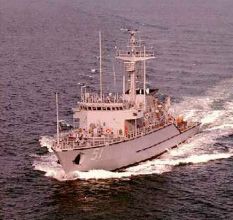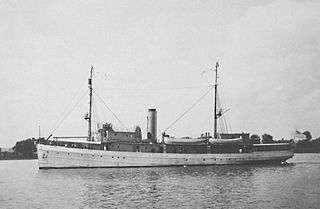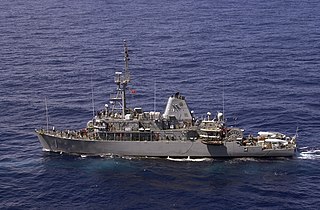
USS Ponce, is an Austin-class amphibious transport dock, formerly in service with the United States Navy. She has been the only ship of the Navy named for Ponce in the Commonwealth of Puerto Rico, which in turn was named after the Spanish explorer Juan Ponce de León, the first governor of Puerto Rico and the European discoverer of Florida. Her keel was laid down on 31 October 1966 by the Lockheed Shipbuilding and Construction Company of Seattle, Washington. She was launched on 20 May 1970 sponsored by Florence W. Hyland, the wife of Admiral John J. Hyland, and commissioned on 10 July 1971. She spent most of her career based on the East Coast and operating in the Atlantic Ocean and Mediterranean Sea, serving in Operation Desert Shield and supporting US operations in the 2011 Libyan Civil War.

The Ton class were coastal minesweepers built in the 1950s for the Royal Navy, but also used by other navies such as the South African Navy and the Royal Australian Navy. They were intended to meet the threat of seabed mines laid in shallow coastal waters, rivers, ports and harbours, a task for which the existing ocean-going minesweepers of the Algerine-class were not suited.

The Osprey class are a series of coastal minehunters designed to find, classify, and destroy moored and bottom naval mines from vital waterways. They use sonar and video systems, cable cutters and a mine detonating device that can be released and detonated by remote control. The Osprey class are the world's second largest minehunters to be constructed entirely of fiberglass and designed to survive the shock of underwater explosions. Their primary mission is reconnaissance, classification, and neutralization of all types of moored and bottom mines in littoral areas, harbors and coastal waterways.

USS Osprey (MHC-51) is the lead ship of Osprey class coastal mine hunters, and the fourth U.S. Navy ship of that name.

USS Pelican (MHC-53) was the third Osprey-class coastal minehunter and the third ship in the Navy to bear the name of the bird. From 1 January 1997 on, Pelican was part of the Naval Reserve Force. In that role the ship was used as training platform for naval reservists. Both decommissioned and stricken from the Navy List on 16 March 2007, Pelican was transferred to the Hellenic Navy the same day. There she was recommissioned as Evniki.

USS Oriole (MHC-55) was an Osprey-class coastal minehunter of the United States Navy. She was built by Intermarine USA and launched in 1993 then commissioned in 1995. After only eleven years of service she was decommissioned in 2006 and sold to Taiwan. She now operates as ROCS Yung Jin (MHC-1310).

USS Kingfisher (MHC-56) was the sixth ship of Osprey-class coastal mine hunters. She is named after the kingfisher.

USS Cormorant (MHC-57) is the seventh ship of Osprey class coastal mine hunters.

USS Black Hawk (MHC-58) was the eighth ship of Osprey-class coastal mine hunters.

USS Cardinal (MHC-60) was the tenth Osprey-class coastal mine hunter in the United States Navy. She was commissioned on 18 October 1997, decommissioned on 7 January 2007 and sold to Egypt.

USS Shrike (MHC-62) is the twelfth and last ship of Osprey-class coastal mine hunters.

USS Osprey (AM-29) was an Lapwing-class minesweeper commissioned by the United States Navy for service in World War I. She was responsible for removing mines from harbors, and, in her role as rescue and salvage ship, she was responsible for coming to the aid of stricken vessels.
USS Owl (AMCU-35) was a LCI(L)-351-class large landing craft of the United States Navy, later converted to an AMCU-7-class coastal minesweeper.
USS LCI(L)-653 was an LCI-351-class landing craft infantry built for the United States Navy during World War II. Decommissioned after the war, she was reactivated in 1953 as minehunter USS Avocet (AMCU-16). She was named for the avocet, a long-legged, web-footed shore bird possessing a slender, up-curved bill, found in western and southern states. She was sold in 1960 and her ultimate fate is unknown.

USS Osprey (AM–56), was a Raven-class minesweeper of the United States Navy, laid down on 28 June 1939 at the Norfolk Navy Yard, Virginia; launched on 24 August 1940; sponsored by Ms. Margaret Kays; and commissioned on 16 December 1940, Lieutenant Commander L. Blackwell in command.
USS PCS-1465 was a PCS-1376-class minesweeper built for the United States Navy during World War II. Late in the war she was renamed and reclassified Minah (AMc-204), and in the 1950s reclassified first as AMCU-14 and later as MHC-14. Named for the myna under a variant spelling, she was the only U.S. Navy ship of that name.
USS Longspur (AMCU-28) was a LCI(L)-351-class large landing craft of the United States Navy, later converted to a AMCU-7-class Coastal Minesweeper.
USS Intrigue (AM-253) was an Admirable-class minesweeper built for the United States Navy during World War II. She served in the Atlantic during World War II. She was decommissioned in May 1946 and placed in reserve. While she remained in reserve, Intrigue was reclassified as MSF-253 in February 1955 but never reactivated. In October 1962, she was sold to the Mexican Navy and renamed ARM DM-19. In 1994, she was renamed ARM Vicente Suárez (C61), and, later converted to a training ship with pennant number A06. She was stricken in July 2001, but her ultimate fate is not reported in secondary sources.

USS Bobolink (AMS-2/YMS-164) was a YMS-1-class minesweeper of the YMS-135 subclass acquired by the U.S. Navy for the task of removing mines that had been placed in the water to prevent ships from passing.

Avenger-class mine countermeasures ships are a class of 14 ships constructed for the United States Navy from 1987 to 1994, designed to clear mines from vital waterways. The ships have the hull designator MCM.


















